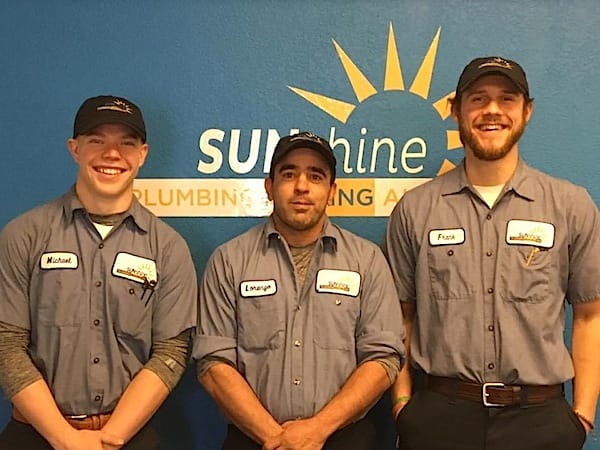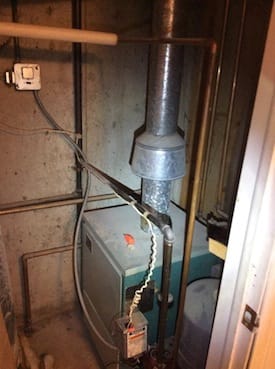A 2016 “Colorado Companies to Watch” winner, Sunshine Plumbing Heating Air, Denver, excels in plumbing and hydronic installations. Since 2006, the company has been fulfilling all the HVAC and plumbing needs of its customers, striving for 100% satisfaction. Case in point: William Frew, Owner/Vice President Sunshine Plumbing Heating Air received a no-heat call at Brian Read more
Whats Next
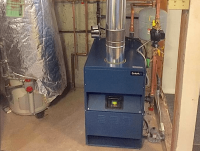
A 2016 “Colorado Companies to Watch” winner, Sunshine Plumbing Heating Air, Denver, excels in plumbing and hydronic installations. Since 2006, the company has been fulfilling all the HVAC and plumbing needs of its customers, striving for 100% satisfaction.
Case in point: William Frew, Owner/Vice President Sunshine Plumbing Heating Air received a no-heat call at Brian Todd’s rental home, an 825-sq.-ft. starter home in Brighton, Colo. Sunshine sent out some of its fastest rising stars: Under the brilliant guidance and watchful eye lead tech Lorenzo DeNigris, Frank Samsel, trained by the PHCC apprentice school in Pennsylvania, and Michael Arneson, who started as a young helper and has excelled in the trade, went to the Todd home to investigate.
When the three arrived at the residence they found the old, original boiler—located in a mechanical closet with no fresh air in the basement—was in disrepair and needed immediate attention, and replacement.
With the help of manufacturer’s rep HSI, Denver, Sunshine selected the Dunkirk DXL 125 cast iron boiler due to its durability and longevity. The hydronic installation includes a Taco 007 circulator, three Honeywell ¾ sweat zone valves (V4043) with a Taco 3-zone valve controller (TZV403) to separate the upstairs, downstairs and bedroom through copper fin baseboard heat. In addition, they opened up the room to allow fresh air and light.
“There are three critical things to consider when selecting a boiler in our area. 1) Are there local manufacturer reps? 2) Can another plumber work on this, if needed? And 3) Are parts readily available? The answer is yes to all three. In fact, the Dunkirk cast iron boiler is one of the most popular boilers in the area,” says Frew.
 Needless to say, the homeowner is very happy with his hydronic comfort, and it’s all in a day’s work for DeNigris, Samsel, Arneson and the entire Sunshine crew. On to the next job.
Needless to say, the homeowner is very happy with his hydronic comfort, and it’s all in a day’s work for DeNigris, Samsel, Arneson and the entire Sunshine crew. On to the next job.
For more on Sunshine Plumbing Heating Air, https://mechanical-hub.com/sites/hydronics/boiler-tankless-install-solves-homeowners-hot-water-concerns/
Dunkirk DXL Series Boilers
Up to 83.5% AFUE Gas Fired Hot Water Boiler
- Dependable Cast Iron Heat Exchanger with Cast Iron Push Nipples. The Sections and Push Nipples expand at the same rate when heated. By using similar materials instead of less expensive gaskets the boiler maintains a water tight seal over time.
- Advanced Fuel Smart Hydrostat Control: 3 Functions in 1 Control
– Temperature limit with LED display and easy dial settings. Diagnostic and function indicator lights.
– Low Water Cut-Off (LWCO), protects the boiler from damaging low water conditions.
– Boiler Reset, lowers the boiler temperature to save fuel by turning on the burner only when needed. Setup is quick with no need to install an outdoor sensor; just dial in the number of heating zones.
- Atmospheric Chimney Vent Boiler with Integral Draft Diverter. The Integral Draft Hood reduces the overall height and footprint of the boiler making it ideal for low clearance/space limited installations.
- Cast to Last Warranty
– 20 year non-prorated limited warranty
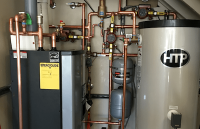
Fruita Colorado lies in a valley between two mountain ranges known for their bizarre rock formations. Just a few miles east of the Utah border, and even fewer miles from the Colorado National Monument to the southeast, Fruita and its neighboring town of Grand Junction look like they were dropped on the face of Mars Read more
Fruita Colorado lies in a valley between two mountain ranges known for their bizarre rock formations. Just a few miles east of the Utah border, and even fewer miles from the Colorado National Monument to the southeast, Fruita and its neighboring town of Grand Junction look like they were dropped on the face of Mars.
Among the rocky outcroppings and giant red monoliths is a unique, free-standing tower known as Independence Monument. Chris McLauhlin, lead installation tech for Coppersmith Plumbing Company knows just where to catch a glimpse of the 450-foot rock formation when he’s driving on Rt. 6, just like he did in late July.
Chris was headed from the Coppersmith shop in Grand Junction to a boiler retrofit job in Fruita. This was like any one of the hundreds of boilers he’s installed since joining the company 16 years ago, except for one thing.

The K2 Firetube can be piped from either the top or the bottom of the unit, a big advantage when installing in small mechanical rooms.
“I really wanted to try out a new fire-tube boiler,” sad McLaughlin. “I’ve installed a few fire-tubes from two or three different manufacturers over the years, but we install mostly Burnham brand equipment. So when I learned that US Boiler had just introduced a new K2 fire-tube, I got my hands on one as quick as I could.”
For roughly as long as they’ve been installing Burnham products, Coppersmith’s first call when it comes to boiler questions if McCoy Sales. Salesmen Mark Doyle and Tim Lindstrom are eager to help if a need arises.
Test drive
Coppersmith has been in business since 1995 and serves western Colorado with eight technicians. Owner Frank Frigetto founded the plumbing and heating business after 14 years in the trade. Born from a passion for the craft, the company’s name and logo are reminiscent of times when everything was hand-forged and built to last. And if you ask around, their reputation matches the image.
They do a wide variety of work, from low-income housing to $5 million, multi-boiler applications. Hydronic installations usually include Burnham cast-iron or Alpine condensing boilers. Over the past year though, some of the work has included K2 models. Regardless of whether they’re buying cast iron or stainless models, product comes through Grand Junction Winsupply. Branch President, Rick Thatcher has been McCoy’s most loyal distributor in Western Colorado.
Coming up this fall, a big boiler replacement project at a townhome property in Aspen, Colo., will hopefully keep Coppersmith busy for a few weeks. They’re bidding the 40-boiler retrofit right now. So McLaughlin wanted to use the single-family retrofit in Fruita to try out the K2 Firetube, hoping to use it later in Aspen.
The 95% AFUE K2 Firetube has a dimpled, stainless steel vertical fire tube heat exchanger and is available in six sizes from 85-270 MBH. A 155-MBH combi version is also available.
“This neighborhood is a retirement community where we installed all the boilers and plumbing 11 years ago,” he explained. “At the time, we were using one of the very first condensing boilers to hit the market. This call was the third we’ve received to replace a boiler.”
In actuality, the homeowner just wanted Coppersmith to fix his boiler, which he’d been tinkering with on his own, after buying parts online. As soon as the owner learned that it would cost almost as much to fix it as it would to replace it with a new stainless steel boiler, he decided that replacement was best for the 1,800 square-foot home. The very next day, McLaughlin arrived to demo the old boiler and remove the old 40-gallon indirect tank.
The old, natural gas system was stuffed under a flight of steps in the garage, feeding three zones of fin-tube baseboard. Working alone, McLaughlin quickly learned that space constraints weren’t an issue for the 85 MBH K2 Firetube. The ability to pipe the supply and return out of either the top or bottom of the boiler was a big advantage. He piped the natural gas line to the underside of the unit with an inch or two to spare, and connected the primary-secondary piping on top. A new 45-gallon indirect tank, set to priority, pulls a fourth zone off the secondary piping.
“Even by myself, everything installed smoothly except for the outdoor reset,” said McLaughlin. “The layout of these houses makes it tough to fish the wire where I want it. I’ll be ordering the wireless ODR kit next time we’re called to this neighborhood.”
A superior fire-tube
From his experience with other fire-tube boilers, McLaughin was expecting the controls to be cumbersome. After setting the warm-weather shutdown to 68°F, he realized that the interface was very similar to the intuitive controls on the Alpine, which he has in his own home. The biggest difference is that the touchscreen control is tilted up for easier viewing.
“I’ve had all sorts of electrical problems with other fire-tubes, so I was a bit concerned at first,” he said. “But I don’t know why I was concerned about it. I’ve never had a Burnham do something it’s not supposed to do. And reading the manual definitely beat trying to decipher the Korean-English I&O manuals that come with the cheap fire-tubes.”
McLaughin noted another thing that separated the K2 Firetube from other boilers, too.
“The condensate drain is solid,” he said. “I like it more than Alpine’s drain, and maybe even more than the one on the K2 Watertube.”
By the end of the first day, the boiler was fired.
On to the next one, or 40
“I went back to the home the next day to clean up wires and walk the owner through his new system,” said McLaughlin. “It was a really quick install, and with a second guy it could’ve easily been done in one day flat.”
The boiler proved to be easier to install than he had expected, though a few other things made it a fast process too. Venting was easy because the original boiler was a high-efficiency model. And the original zone vales and air strainer were left in place to help keep the cost as low as possible.
The installation in Fruita showed Coppersmith what they were hoping to learn: Whether or not the K2 Firetube would be a good choice for the row-homes in Aspen. The jobs are very similar, with well-constructed houses that don’t offer much mechanical space. The main differences in Aspen are the radiation and the altitude: Instead of fin-tube, the row homes use fan coils. And where Fruita lies at 4,500 feet above sea level, requiring a 4% input derate, Aspen rests at about 8,000.
“There’s no doubt that the K2 is my favorite fire-tube on the market,” said McLaughlin. “It might be too soon to decide if I like it more than the Alpine, but that’s the way it’s looking. With any luck, I’ll know the answer to that after we install 40 of them in Aspen this fall.”
Products:
Boiler: 85 MBH US Boiler K2 Firetube
System Circulator: Grundfos 3-speed
Flanges: Webstone
Air separator: Caleffi
Boiler drain: Red and White
Ball valves and fittings: Nibco
Zone valves: Honeywell
Backflow preventer: Watts
Tools:
Reed pipe cutters
Turbo torch
Rigid pipe wrenches
Klein tools
Knipex wrenches
Testso combustion analyzer
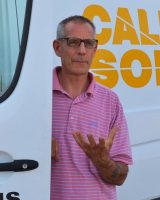
We hear the phrase that water is the universal solvent. Why? So many materials dissolve in water due to its unique molecular structure. So it does not seem like a fluid to be used in a hydronic heating system made of many different materials. Water does have many advantages as a heat transfer material. It Read more
We hear the phrase that water is the universal solvent. Why? So many materials dissolve in water due to its unique molecular structure. So it does not seem like a fluid to be used in a hydronic heating system made of many different materials. Water does have many advantages as a heat transfer material. It is cheap, safe, easily acquired, has a wide liquid temperature range, and is generally non-toxic.
With water coming from so many different sources worldwide, it can contain many different minerals. It is the wide combination of these minerals that water gathers as it flows through our aquifers that needs attention.
Many of the common minerals found in water will cause issues in hydronic systems. The hardness of the water, and minerals that fall from solution, are the most common concerns. As the minerals precipitate out, they can stick to and coat the surfaces of our boiler heat exchangers, for example. This coating forms until enough build-up reduces the heat exchange and the metal of the heat exchanger breaks down. A classic example is what you see when you drain an old tank-style water heater. Some of the material that can be found in tap water cause further concern…like chlorides.
Boiler and tank manufacturers are now listing the most harmful minerals as well as acceptable levels. Calcium, magnesium, chlorides, and sulfates are commonly listed. The ph level is also required to fall within a range, something like 6.6 and 8.5 according to one boiler specification.
Failure to maintain the proper water chemistry can cause loss of efficiency, noise, wear, premature failure, and most important to the consumer, lack of warranty.
So the industry needs to first get some training on what to look for, how to measure levels, and what to do with water that does not meet the quality required to assure warranty coverage.
Most agree that starting with good quality water is one key. It is possible that the water in your town is of sufficient quality. But if you are not testing, you are guessing. Know also that water quality in an area can vary season to season. One of the most noticeable changes in water quality can be linked to the road deicing chemicals used. Back in the day, rock salt, maybe blended with sand, was the go to deicer. Nowadays chloride blends are being used in may states. Chlorides have a wider melt range, and can be applied as a liquid. They often get applied before a snowstorm, or icing condition as a proactive measure.
Guess where these chlorides end up? In our water supplies, via lakes, rivers, and even well sources. Many water sources have been seeing a spike in chlorides. States like Wisconsin and Minnesota have been monitoring this carefully as the aquatic life in their thousands of lakes and rivers are being affected by the elevated chlorides, as well as the flora and fauna.
There is a fairly simple fix for water that is not of sufficient quality for use in hydronic systems. Both deionizing and chemical treatments are available to help bring water back to a hydronic-friendly heat transfer fluid.
Flush your systems. Consider a hydronic detergent to rid the system of oil, flux, dirt, etc. Test the water for the final fill, and treat as required, or haul quality water from another source.
You will be hearing more about boiler water quality as manufacturers of boilers, tanks, pumps, valves, etc. start reexamining warranty returns that have been compromised by fluid quality. It will be a tough conversation to have with a home or building owner if an expensive component fails prematurely due to fluid quality and the warranty is refused.
 Hot Rod is currently the training and education manager for Caleffi North America. He owned his own contracting company, Show Me Radiant Heat & Solar, Rogersville, Mo., having been a plumbing and heating contractor since 1978.
Hot Rod is currently the training and education manager for Caleffi North America. He owned his own contracting company, Show Me Radiant Heat & Solar, Rogersville, Mo., having been a plumbing and heating contractor since 1978.
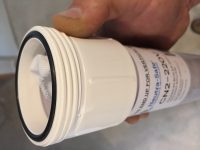
Job Scope: Remote lake home with hydronics ceilings & panel radiators Dual-fuel system (Electric boiler w/ High efficiency back-up) Septic waste system for onsite waste removal The majority of new or replacement heating system installations include high efficiency condensing appliances. The condensate is produced as a product of the appliance operation; in this case the Read more
Job Scope:
- Remote lake home with hydronics ceilings & panel radiators
- Dual-fuel system (Electric boiler w/ High efficiency back-up)
- Septic waste system for onsite waste removal
The majority of new or replacement heating system installations include high efficiency condensing appliances. The condensate is produced as a product of the appliance operation; in this case the boiler extracts additional btu’s contained in the water vapor of the flue gasses. When the flue gas temperatures drop below the approximate dew point of 135°F the water vapor condenses and the resulting liquid is acidic. This acidic condensate liquid requires treatment to avoid damage to piping systems, septic systems, treatment facilities and other items it may come in contact with. Many municipalities now require condensate treatment with all new installs and permitted replacements.
Read more about condensate neutralizing here:
The importance of neutralizing condensate produced by high efficiency gas fired appliances
A recent family lake home project gave me the opportunity to install the Neutra-Safe clear tube style neutralizer model CN-220V. You may be familiar already with neutralizers but I assure you this one is different than others I have installed in the past. The expected wholesale cost of the kit should be approximately $50-60.
Product Specs:
- Capacity – 220,000 BTU/hr
- Connection/fitting size – ½” MPT / ¾” PVC Female Solvent Weld
- Tube body size – 2”
- Integral unions w/ O-ring seal (for servicing)
- Stainless Steel screen on inlet to prevent plugging of unit
- Media (included) – Calcite & magnesium oxide pellets (bagged/contained)
The CN2-220V is an “up-flow” or vertical neutralizer. This means the condensate enters the neutralizer at the bottom of the 2” clear plastic body, as the condensate passes thru the filter media it exits out the top center where piping is routed to a nearby drain or pump. This design assures all condensate passes thru the media where other designs do not require the entire media area to be flooded; thus allowing for small flow rates to pass thru a neutralizer without fully filtering and neutralizing above the typical PH of 2-4. The photo below shows a typical installation with the [included] mounting hardware and drain tubing routing.

Body & Media pictured here. Media shipped and installed bagged to prevent media materials clogging drain tubing.
I’ve installed multiple brands of neutralizers in the past, the CN2-220V is the first to include all the necessary mounting hardware, fittings for initial tubing connections and bagged media for ease of installation, this being all in one package negating the need to source additional parts to finish the install. Of course drain tubing is field supplied, along with the needed fittings for full installation.
 The Neutra-Safe tube style neutralizers feature integral unions with O-ring seals that greatly simplify removal for service and recharging. Un-threading a lock ring on either end of the unit allows the main body to be removed without disturbing the drain line. Replacement O-rings are included with tube style recharge kits and all tube style neutralizers are available with a snap-in mounting clamp option.
The Neutra-Safe tube style neutralizers feature integral unions with O-ring seals that greatly simplify removal for service and recharging. Un-threading a lock ring on either end of the unit allows the main body to be removed without disturbing the drain line. Replacement O-rings are included with tube style recharge kits and all tube style neutralizers are available with a snap-in mounting clamp option.
The media replacement schedule is one year, they’ve even included a model number sticker on the tube where you can write the date of installation/replacement for reference. You should expect the wholesale cost of media replacement, which includes the o-rings and bagged media, to be approximately $25-30.

Being that this installation was the first time I had held the product in my hands I can say it did take me a few minutes to figure out how the included fittings and tube were to be assembled but the included instructions made for a simple install.
I’ve seen many times the effects of acidic condensate can have on piping systems, floor drains and concrete surfaces and that is why I include a neutralizer with all my high efficiency installs. Furthermore, many of the municipalities in my area are requiring them for both new installs and replacements.
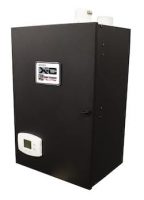
The new, value-priced X-C high-efficiency boiler is an addition to U.S. Boiler Company’s broad line of stainless steel condensing boilers. It’s available in five sizes from 80 to 180 MBH and provides up to 95% AFUE at an extremely competitive price. A factory-preset Sage 2.2 control system and LCD display offer straightforward set-up and diagnostics Read more
 The new, value-priced X-C high-efficiency boiler is an addition to U.S. Boiler Company’s broad line of stainless steel condensing boilers. It’s available in five sizes from 80 to 180 MBH and provides up to 95% AFUE at an extremely competitive price.
The new, value-priced X-C high-efficiency boiler is an addition to U.S. Boiler Company’s broad line of stainless steel condensing boilers. It’s available in five sizes from 80 to 180 MBH and provides up to 95% AFUE at an extremely competitive price.
A factory-preset Sage 2.2 control system and LCD display offer straightforward set-up and diagnostics, while a standard outdoor reset control saves fuel for the end-user. The X-C boiler is system tested at the factory and comes with a five-year parts warranty.
Joining the K2 Watertube, K2 Firetube and Alpine models as another easily-installed, easily-serviced condensing boiler, the X-C offers a feature-packed solution for the budget-minded customer. In all, US Boiler now offers stainless steel, condensing models from 80 to 800 MBH, with multiple heat exchanger options.

